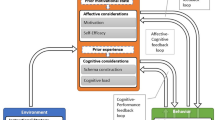Abstract
This study examined the effects of type of instructional control and program mode on the achievement, option use, time in the program, and attitudes of higher-ability and lower-ability university students. Ability level was determined using participants' Scholastic Aptitude Test (SAT) and American College Testing Assessment (ACT) scores. Participants were randomly assigned to four versions of a computer-delivered instructional program within higher-ability and lower-ability groups. The four versions of the instructional program were created by crossing the two control conditions (learner control, program control) with the two program modes (full, lean). Participants in the full program scored significantly higher on the posttest than those in the lean program, and higher-ability students scored significantly higher than lower-ability students. Learner-control participants chose to view 68% of the optional screens in the full program but only 35% in the lean one, and participants also spent significantly more time in the full version. Participants had more favorable attitudes toward learner control than program control.
Similar content being viewed by others
References
Brennan, R.L. & Kolen, M.J. (1989).Scaling the ACT assessment and P-ACT+: Rationale and goals. Iowa City: ACT Publications.
Carrier, C.A., Davidson, G.V., Higson, V., & Williams, M. (1984). Selection of options by field independent and dependent children in a computer-based concept lesson.Journal of Computer-Based Instruction, 11(2), 49–54.
Carrier, C.A., Davidson, G.V., & Williams, M. (1985). The selection of instructional options in a computer-based coordinate concept lesson.Educational Communications and Technology Journal, 33, 199–212.
Carrier, C.A., Davidson, G.V., Williams, M.D., & Kalweit, C.M. (1986). Instructional options and encouragement effects in a microcomputer-delivered concept lesson.Journal of Educational Research, 79, 222–229.
Carrier, C.A., & Williams, M.D. (1988). A test of one learner-control strategy with students of differing levels of task persistence.American Educational Research Journal, 25, 285–306.
Comras, J. (1984).The SAT—What does it measure and does it still work? New York: The College Board.
Freitag, E.T., & Sullivan, H.J. (1995). Matching learner preference for amount of instruction: An alternative form of learner control.Educational Technology Research and Development, 43(2), 5–14.
Goetzfried, L., & Hannafin, M.J. (1985). The effect of the locus of CAI control strategies on the learning of mathematics rules.American Educational Research Journal, 22(2), 273–278.
Gray, S.H. (1987). The effect of sequence control on computer assisted learning.Journal of Computer-Based Instruction, 14(2), 54–56.
Hannafin, R.D., & Sullivan, H.J. (1995). Learner control in full and lean CAI programs.Educational Technology Research and Development, 43(1), 19–30.
Hannafin, R.D., & Sullivan, H.J. (1996). Preferences and learner control over amount of instruction.Journal of Educational Psychology, 88(1), 162–173.
Hativa, N. (1988). Differential characteristics and methods of operation underlying CAI/CMI drill and practice systems.Journal of Research on Computing in Education, 20, 258–270.
Hicken, S., Sullivan, H., & Klein, J.D. (1992). Learner control modes and incentive variations in computer-delivered instruction.Educational Technology Research and Development, 40(4), 15–26.
Igoe, A.R. (1993).Learner control over instruction and achievement goals in computer-assisted instruction. Unpublished doctoral dissertation, Arizona State University, Tempe.
Kinzie, M.B., & Sullivan, H.J. (1989). Continuing motivation, learner control, and CAI.Educational Technology Research and Development, 37(2), 5–14.
Kinzie, M.B., Sullivan, H.J., & Berdel, R.L. (1988). Learner control and achievement in science computer-assisted instruction.Journal of Educational Psychology, 80(3), 299–303.
Lopez, C.L., & Harper, M. (1989). The relationship between learner control of CAI and locus of control among Hispanic students.Educational Technology Research and Development, 37(4), 19–28.
Mager, R.F. (1964). Learner-controlled instruction—1958–1964.Programmed Instruction, 4(2), 1, 8, 10–12.
Merrill, M.D. (1975). Learner control: Beyond aptitude-treatment interactions.AV Communications Review, 23, 217–226.
Merrill, M.D. (1980). Learner control in computer based learning.Computers and Education, 4, 77–95.
Morrison, G.R., Ross, S.M., & Baldwin, W. (1992). Learner control of context and instructional support in learning elementary school mathematics.Educational Technology Research and Development, 40(1), 5–13.
Pascal, C.E. (1971). Instructional options, option preference, and course outcomes.The Alberta Journal of Educational Research, 17(1), 1–11.
Peterson, T.C., & Janicki, P.L. (1979). Individual characteristics and children's learning in large-group and small-group approaches.Journal of Educational Psychology, 71(5), 677–687.
Pollock, J.C., & Sullivan, H.J. (1990). Practice mode and learner control in computer-based instruction.Contemporary Educational Psychology, 15, 251–260.
Ross, S.M., Morrison, G.R., & O'Dell, J.K. (1989). Uses and effects of learner control of context and instructional support in computer-based instruction.Educational Technology Research and Development, 37(4), 29–39.
Ross, S.M., & Rakow, E.A. (1981). Learner control versus program control as adaptive strategies for selection of instructional support on math rules.Journal of Educational Psychology, 73(5).
Schnackenberg, H.L., Sullivan, H.J., Leader, L.F., & Jones, E.E.K. (1998). Learner Preferences and Learner Achievement Under Differing Amounts of Instruction.Educational Technology Research and Development, 46(2), 5–15.
Steinberg, E.R. (1977). Review of student control in computer-assisted instruction.Journal of Computer-Based Instruction, 3, 84–90.
Sullivan, H., & Higgins, N. (1983).Teaching for comptence. New York: Teachers College Press.
Tennyson, R.D. (1980). Instructional control strategies and content structures as design variables in concept acquisition using computer-based instruction.Journal of Educational Psychology, 72(4), 525–532.
Tennyson, R.D., & Buttrey, T. (1980). Advisement and management strategies as design variables in computer-assisted instruction.Educational Communication and Technology Journal, 28, 169–176.
Tennyson, R.D., & Rothen, W. (1977). Pretask and on-task adaptive design strategies for selecting number of instances in conceptual acquisition.Journal of Educational Psychology, 69, 586–592.
Author information
Authors and Affiliations
Rights and permissions
About this article
Cite this article
Schnackenberg, H.L., Sullivan, H.J. Learner control over full and lean computer-based instruction under differing ability levels. ETR&D 48, 19–35 (2000). https://doi.org/10.1007/BF02313399
Issue Date:
DOI: https://doi.org/10.1007/BF02313399




